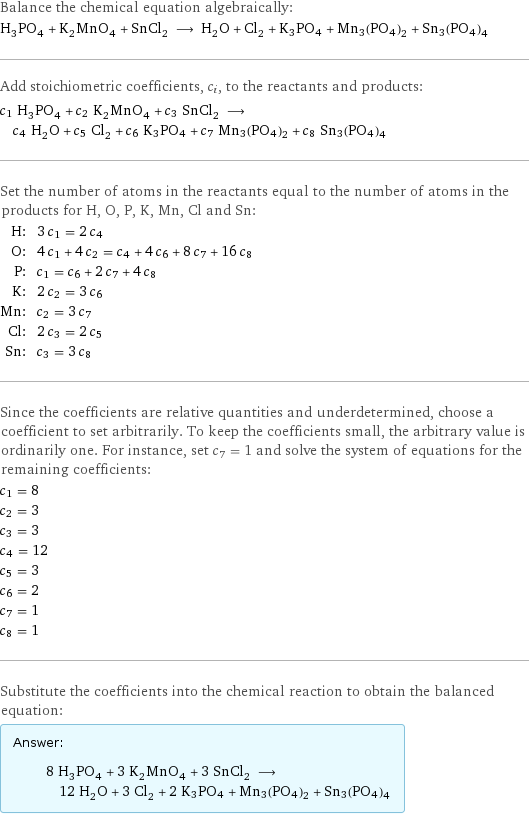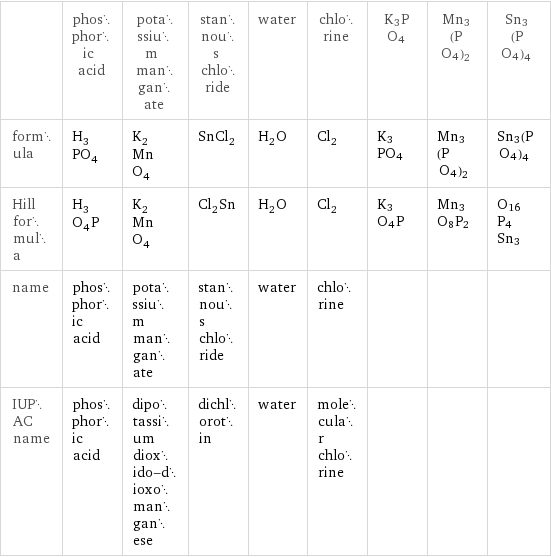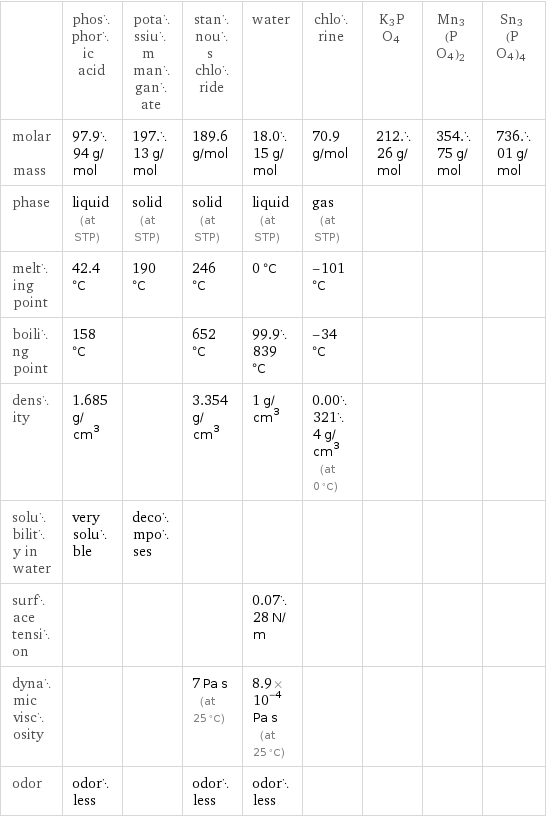Input interpretation

H_3PO_4 phosphoric acid + K_2MnO_4 potassium manganate + SnCl_2 stannous chloride ⟶ H_2O water + Cl_2 chlorine + K3PO4 + Mn3(PO4)2 + Sn3(PO4)4
Balanced equation

Balance the chemical equation algebraically: H_3PO_4 + K_2MnO_4 + SnCl_2 ⟶ H_2O + Cl_2 + K3PO4 + Mn3(PO4)2 + Sn3(PO4)4 Add stoichiometric coefficients, c_i, to the reactants and products: c_1 H_3PO_4 + c_2 K_2MnO_4 + c_3 SnCl_2 ⟶ c_4 H_2O + c_5 Cl_2 + c_6 K3PO4 + c_7 Mn3(PO4)2 + c_8 Sn3(PO4)4 Set the number of atoms in the reactants equal to the number of atoms in the products for H, O, P, K, Mn, Cl and Sn: H: | 3 c_1 = 2 c_4 O: | 4 c_1 + 4 c_2 = c_4 + 4 c_6 + 8 c_7 + 16 c_8 P: | c_1 = c_6 + 2 c_7 + 4 c_8 K: | 2 c_2 = 3 c_6 Mn: | c_2 = 3 c_7 Cl: | 2 c_3 = 2 c_5 Sn: | c_3 = 3 c_8 Since the coefficients are relative quantities and underdetermined, choose a coefficient to set arbitrarily. To keep the coefficients small, the arbitrary value is ordinarily one. For instance, set c_7 = 1 and solve the system of equations for the remaining coefficients: c_1 = 8 c_2 = 3 c_3 = 3 c_4 = 12 c_5 = 3 c_6 = 2 c_7 = 1 c_8 = 1 Substitute the coefficients into the chemical reaction to obtain the balanced equation: Answer: | | 8 H_3PO_4 + 3 K_2MnO_4 + 3 SnCl_2 ⟶ 12 H_2O + 3 Cl_2 + 2 K3PO4 + Mn3(PO4)2 + Sn3(PO4)4
Structures

+ + ⟶ + + K3PO4 + Mn3(PO4)2 + Sn3(PO4)4
Names

phosphoric acid + potassium manganate + stannous chloride ⟶ water + chlorine + K3PO4 + Mn3(PO4)2 + Sn3(PO4)4
Equilibrium constant
![Construct the equilibrium constant, K, expression for: H_3PO_4 + K_2MnO_4 + SnCl_2 ⟶ H_2O + Cl_2 + K3PO4 + Mn3(PO4)2 + Sn3(PO4)4 Plan: • Balance the chemical equation. • Determine the stoichiometric numbers. • Assemble the activity expression for each chemical species. • Use the activity expressions to build the equilibrium constant expression. Write the balanced chemical equation: 8 H_3PO_4 + 3 K_2MnO_4 + 3 SnCl_2 ⟶ 12 H_2O + 3 Cl_2 + 2 K3PO4 + Mn3(PO4)2 + Sn3(PO4)4 Assign stoichiometric numbers, ν_i, using the stoichiometric coefficients, c_i, from the balanced chemical equation in the following manner: ν_i = -c_i for reactants and ν_i = c_i for products: chemical species | c_i | ν_i H_3PO_4 | 8 | -8 K_2MnO_4 | 3 | -3 SnCl_2 | 3 | -3 H_2O | 12 | 12 Cl_2 | 3 | 3 K3PO4 | 2 | 2 Mn3(PO4)2 | 1 | 1 Sn3(PO4)4 | 1 | 1 Assemble the activity expressions accounting for the state of matter and ν_i: chemical species | c_i | ν_i | activity expression H_3PO_4 | 8 | -8 | ([H3PO4])^(-8) K_2MnO_4 | 3 | -3 | ([K2MnO4])^(-3) SnCl_2 | 3 | -3 | ([SnCl2])^(-3) H_2O | 12 | 12 | ([H2O])^12 Cl_2 | 3 | 3 | ([Cl2])^3 K3PO4 | 2 | 2 | ([K3PO4])^2 Mn3(PO4)2 | 1 | 1 | [Mn3(PO4)2] Sn3(PO4)4 | 1 | 1 | [Sn3(PO4)4] The equilibrium constant symbol in the concentration basis is: K_c Mulitply the activity expressions to arrive at the K_c expression: Answer: | | K_c = ([H3PO4])^(-8) ([K2MnO4])^(-3) ([SnCl2])^(-3) ([H2O])^12 ([Cl2])^3 ([K3PO4])^2 [Mn3(PO4)2] [Sn3(PO4)4] = (([H2O])^12 ([Cl2])^3 ([K3PO4])^2 [Mn3(PO4)2] [Sn3(PO4)4])/(([H3PO4])^8 ([K2MnO4])^3 ([SnCl2])^3)](../image_source/2b7da61079ab2608706730ac37d8805e.png)
Construct the equilibrium constant, K, expression for: H_3PO_4 + K_2MnO_4 + SnCl_2 ⟶ H_2O + Cl_2 + K3PO4 + Mn3(PO4)2 + Sn3(PO4)4 Plan: • Balance the chemical equation. • Determine the stoichiometric numbers. • Assemble the activity expression for each chemical species. • Use the activity expressions to build the equilibrium constant expression. Write the balanced chemical equation: 8 H_3PO_4 + 3 K_2MnO_4 + 3 SnCl_2 ⟶ 12 H_2O + 3 Cl_2 + 2 K3PO4 + Mn3(PO4)2 + Sn3(PO4)4 Assign stoichiometric numbers, ν_i, using the stoichiometric coefficients, c_i, from the balanced chemical equation in the following manner: ν_i = -c_i for reactants and ν_i = c_i for products: chemical species | c_i | ν_i H_3PO_4 | 8 | -8 K_2MnO_4 | 3 | -3 SnCl_2 | 3 | -3 H_2O | 12 | 12 Cl_2 | 3 | 3 K3PO4 | 2 | 2 Mn3(PO4)2 | 1 | 1 Sn3(PO4)4 | 1 | 1 Assemble the activity expressions accounting for the state of matter and ν_i: chemical species | c_i | ν_i | activity expression H_3PO_4 | 8 | -8 | ([H3PO4])^(-8) K_2MnO_4 | 3 | -3 | ([K2MnO4])^(-3) SnCl_2 | 3 | -3 | ([SnCl2])^(-3) H_2O | 12 | 12 | ([H2O])^12 Cl_2 | 3 | 3 | ([Cl2])^3 K3PO4 | 2 | 2 | ([K3PO4])^2 Mn3(PO4)2 | 1 | 1 | [Mn3(PO4)2] Sn3(PO4)4 | 1 | 1 | [Sn3(PO4)4] The equilibrium constant symbol in the concentration basis is: K_c Mulitply the activity expressions to arrive at the K_c expression: Answer: | | K_c = ([H3PO4])^(-8) ([K2MnO4])^(-3) ([SnCl2])^(-3) ([H2O])^12 ([Cl2])^3 ([K3PO4])^2 [Mn3(PO4)2] [Sn3(PO4)4] = (([H2O])^12 ([Cl2])^3 ([K3PO4])^2 [Mn3(PO4)2] [Sn3(PO4)4])/(([H3PO4])^8 ([K2MnO4])^3 ([SnCl2])^3)
Rate of reaction
![Construct the rate of reaction expression for: H_3PO_4 + K_2MnO_4 + SnCl_2 ⟶ H_2O + Cl_2 + K3PO4 + Mn3(PO4)2 + Sn3(PO4)4 Plan: • Balance the chemical equation. • Determine the stoichiometric numbers. • Assemble the rate term for each chemical species. • Write the rate of reaction expression. Write the balanced chemical equation: 8 H_3PO_4 + 3 K_2MnO_4 + 3 SnCl_2 ⟶ 12 H_2O + 3 Cl_2 + 2 K3PO4 + Mn3(PO4)2 + Sn3(PO4)4 Assign stoichiometric numbers, ν_i, using the stoichiometric coefficients, c_i, from the balanced chemical equation in the following manner: ν_i = -c_i for reactants and ν_i = c_i for products: chemical species | c_i | ν_i H_3PO_4 | 8 | -8 K_2MnO_4 | 3 | -3 SnCl_2 | 3 | -3 H_2O | 12 | 12 Cl_2 | 3 | 3 K3PO4 | 2 | 2 Mn3(PO4)2 | 1 | 1 Sn3(PO4)4 | 1 | 1 The rate term for each chemical species, B_i, is 1/ν_i(Δ[B_i])/(Δt) where [B_i] is the amount concentration and t is time: chemical species | c_i | ν_i | rate term H_3PO_4 | 8 | -8 | -1/8 (Δ[H3PO4])/(Δt) K_2MnO_4 | 3 | -3 | -1/3 (Δ[K2MnO4])/(Δt) SnCl_2 | 3 | -3 | -1/3 (Δ[SnCl2])/(Δt) H_2O | 12 | 12 | 1/12 (Δ[H2O])/(Δt) Cl_2 | 3 | 3 | 1/3 (Δ[Cl2])/(Δt) K3PO4 | 2 | 2 | 1/2 (Δ[K3PO4])/(Δt) Mn3(PO4)2 | 1 | 1 | (Δ[Mn3(PO4)2])/(Δt) Sn3(PO4)4 | 1 | 1 | (Δ[Sn3(PO4)4])/(Δt) (for infinitesimal rate of change, replace Δ with d) Set the rate terms equal to each other to arrive at the rate expression: Answer: | | rate = -1/8 (Δ[H3PO4])/(Δt) = -1/3 (Δ[K2MnO4])/(Δt) = -1/3 (Δ[SnCl2])/(Δt) = 1/12 (Δ[H2O])/(Δt) = 1/3 (Δ[Cl2])/(Δt) = 1/2 (Δ[K3PO4])/(Δt) = (Δ[Mn3(PO4)2])/(Δt) = (Δ[Sn3(PO4)4])/(Δt) (assuming constant volume and no accumulation of intermediates or side products)](../image_source/cfc8df9e123348ffe5fbdfea3adc188a.png)
Construct the rate of reaction expression for: H_3PO_4 + K_2MnO_4 + SnCl_2 ⟶ H_2O + Cl_2 + K3PO4 + Mn3(PO4)2 + Sn3(PO4)4 Plan: • Balance the chemical equation. • Determine the stoichiometric numbers. • Assemble the rate term for each chemical species. • Write the rate of reaction expression. Write the balanced chemical equation: 8 H_3PO_4 + 3 K_2MnO_4 + 3 SnCl_2 ⟶ 12 H_2O + 3 Cl_2 + 2 K3PO4 + Mn3(PO4)2 + Sn3(PO4)4 Assign stoichiometric numbers, ν_i, using the stoichiometric coefficients, c_i, from the balanced chemical equation in the following manner: ν_i = -c_i for reactants and ν_i = c_i for products: chemical species | c_i | ν_i H_3PO_4 | 8 | -8 K_2MnO_4 | 3 | -3 SnCl_2 | 3 | -3 H_2O | 12 | 12 Cl_2 | 3 | 3 K3PO4 | 2 | 2 Mn3(PO4)2 | 1 | 1 Sn3(PO4)4 | 1 | 1 The rate term for each chemical species, B_i, is 1/ν_i(Δ[B_i])/(Δt) where [B_i] is the amount concentration and t is time: chemical species | c_i | ν_i | rate term H_3PO_4 | 8 | -8 | -1/8 (Δ[H3PO4])/(Δt) K_2MnO_4 | 3 | -3 | -1/3 (Δ[K2MnO4])/(Δt) SnCl_2 | 3 | -3 | -1/3 (Δ[SnCl2])/(Δt) H_2O | 12 | 12 | 1/12 (Δ[H2O])/(Δt) Cl_2 | 3 | 3 | 1/3 (Δ[Cl2])/(Δt) K3PO4 | 2 | 2 | 1/2 (Δ[K3PO4])/(Δt) Mn3(PO4)2 | 1 | 1 | (Δ[Mn3(PO4)2])/(Δt) Sn3(PO4)4 | 1 | 1 | (Δ[Sn3(PO4)4])/(Δt) (for infinitesimal rate of change, replace Δ with d) Set the rate terms equal to each other to arrive at the rate expression: Answer: | | rate = -1/8 (Δ[H3PO4])/(Δt) = -1/3 (Δ[K2MnO4])/(Δt) = -1/3 (Δ[SnCl2])/(Δt) = 1/12 (Δ[H2O])/(Δt) = 1/3 (Δ[Cl2])/(Δt) = 1/2 (Δ[K3PO4])/(Δt) = (Δ[Mn3(PO4)2])/(Δt) = (Δ[Sn3(PO4)4])/(Δt) (assuming constant volume and no accumulation of intermediates or side products)
Chemical names and formulas

| phosphoric acid | potassium manganate | stannous chloride | water | chlorine | K3PO4 | Mn3(PO4)2 | Sn3(PO4)4 formula | H_3PO_4 | K_2MnO_4 | SnCl_2 | H_2O | Cl_2 | K3PO4 | Mn3(PO4)2 | Sn3(PO4)4 Hill formula | H_3O_4P | K_2MnO_4 | Cl_2Sn | H_2O | Cl_2 | K3O4P | Mn3O8P2 | O16P4Sn3 name | phosphoric acid | potassium manganate | stannous chloride | water | chlorine | | | IUPAC name | phosphoric acid | dipotassium dioxido-dioxomanganese | dichlorotin | water | molecular chlorine | | |
Substance properties

| phosphoric acid | potassium manganate | stannous chloride | water | chlorine | K3PO4 | Mn3(PO4)2 | Sn3(PO4)4 molar mass | 97.994 g/mol | 197.13 g/mol | 189.6 g/mol | 18.015 g/mol | 70.9 g/mol | 212.26 g/mol | 354.75 g/mol | 736.01 g/mol phase | liquid (at STP) | solid (at STP) | solid (at STP) | liquid (at STP) | gas (at STP) | | | melting point | 42.4 °C | 190 °C | 246 °C | 0 °C | -101 °C | | | boiling point | 158 °C | | 652 °C | 99.9839 °C | -34 °C | | | density | 1.685 g/cm^3 | | 3.354 g/cm^3 | 1 g/cm^3 | 0.003214 g/cm^3 (at 0 °C) | | | solubility in water | very soluble | decomposes | | | | | | surface tension | | | | 0.0728 N/m | | | | dynamic viscosity | | | 7 Pa s (at 25 °C) | 8.9×10^-4 Pa s (at 25 °C) | | | | odor | odorless | | odorless | odorless | | | |
Units
